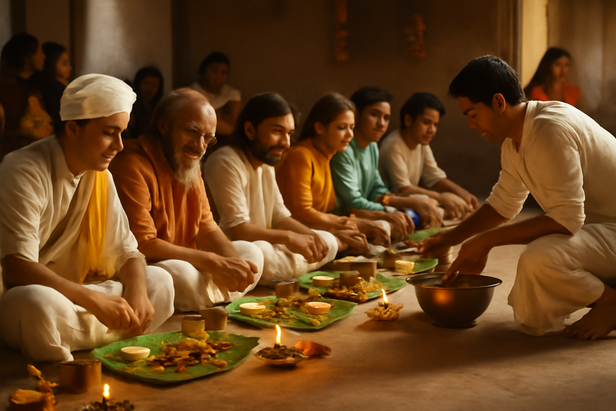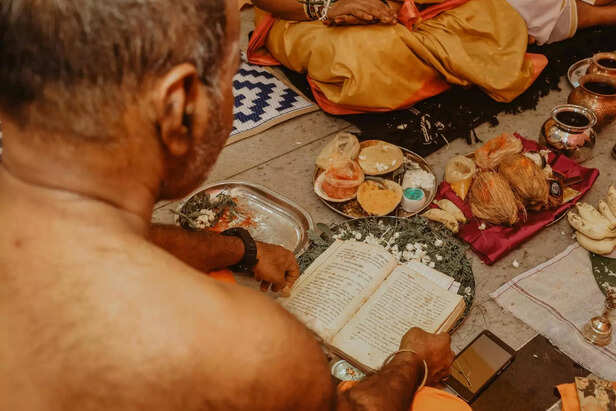Why Charity During Shradh Is Said to Free Generations of Karma
Megha Jangra | Times Life Bureau | Sep 09, 2025, 08:30 IST
Sacred Flames: Ritual on the Ganges
( Image credit : Unsplash )
Shradh is a tradition in Hindu culture that honors ancestors through prayers, offerings, and acts of kindness. Among its many elements, charity and feeding Brahmins (or others in some communities) hold special importance. This article looks at how these practices are described in ancient texts, their social and spiritual logic, and how they are understood today, without taking a fixed religious position.
Shradh is an ancestral remembrance practice in Hindu tradition, observed especially during Pitru Paksha, a fortnight believed to be dedicated to the souls of departed ancestors (Pitṛs). It involves prayers, offerings, and acts of service meant to honor those who came before us. Among the most discussed elements of Shradh are acts of charity (dāna) and feeding Brahmins (Brahman Bhoj).
Over time, these practices have been interpreted in different ways, as spiritual duties, symbolic gestures of gratitude, and even as social customs that strengthened communities. This article explores these elements as they appear in Hindu texts and traditions, while acknowledging that interpretations may vary.

At its core, Shradh is about gratitude. It reflects the belief that life is a continuation of generations, that we inherit not only genes and property but also values, knowledge, and opportunities. By honoring ancestors through offerings and acts of kindness, people symbolically express thanks and seek blessings for future generations.
Ancient texts often describe Shradh as a way of ensuring peace for the departed soul and merit (puṇya) for the living. While the metaphysical aspects cannot be proven or disproven, the emotional and cultural value is widely recognized.

Acts of giving during Shradh are seen as transferring merit to ancestors. Traditional offerings include food, clothes, or other essentials, often given to those in need.
From a spiritual perspective, these offerings are described as reaching ancestors through divine channels. From a social perspective, they redistribute resources, reinforcing a culture of generosity. Regardless of belief, such acts promote empathy and strengthen community bonds, values that remain relevant across time and cultures.

One of the oldest customs in Shradh is feeding Brahmins. Historically, Brahmins were custodians of sacred texts and performed rituals with specific mantras, which were believed to help direct offerings to the ancestors. Feeding them was seen as a way of honoring knowledge-bearers who connected the living with the departed.
However, over centuries, this practice has evolved. In many communities today, instead of restricting offerings to Brahmins, people choose to feed anyone, priests, neighbors, guests, monks, or entire groups of the needy, reflecting a broader idea that feeding the living is the purest form of respect for the departed.

Different Hindu texts refer to Shradh practices, but they vary by time, region, and interpretation. A few often-cited sources include:

When seen beyond literal belief, charity and feeding during Shradh carry messages that remain timeless:
Charity and feeding Brahmins (or others) in Shradh rituals illustrate how societies express respect for the past while serving the present. Over centuries, these customs have evolved, reinterpreted by communities while holding onto their core values of gratitude, generosity, and remembrance.
Ultimately, the heart of Shradh lies not in who is fed or what is given, but in the spirit of honoring those who came before us, with sincerity, kindness, and an understanding that remembering the past helps guide the future.
Over time, these practices have been interpreted in different ways, as spiritual duties, symbolic gestures of gratitude, and even as social customs that strengthened communities. This article explores these elements as they appear in Hindu texts and traditions, while acknowledging that interpretations may vary.
The Essence of Shradh

Young Monks Performing Ritual on Ganges River
( Image credit : Pexels )
At its core, Shradh is about gratitude. It reflects the belief that life is a continuation of generations, that we inherit not only genes and property but also values, knowledge, and opportunities. By honoring ancestors through offerings and acts of kindness, people symbolically express thanks and seek blessings for future generations.
Ancient texts often describe Shradh as a way of ensuring peace for the departed soul and merit (puṇya) for the living. While the metaphysical aspects cannot be proven or disproven, the emotional and cultural value is widely recognized.
Charity (Dāna) in Shradh

Generosity in Action: Shradh Dāna
( Image credit : Times Life Bureau )
Acts of giving during Shradh are seen as transferring merit to ancestors. Traditional offerings include food, clothes, or other essentials, often given to those in need.
From a spiritual perspective, these offerings are described as reaching ancestors through divine channels. From a social perspective, they redistribute resources, reinforcing a culture of generosity. Regardless of belief, such acts promote empathy and strengthen community bonds, values that remain relevant across time and cultures.
Feeding Brahmins (Brahman Bhoj) and Its Evolution

Feeding Brahmins: Tradition and Transformation
( Image credit : Times Life Bureau )
One of the oldest customs in Shradh is feeding Brahmins. Historically, Brahmins were custodians of sacred texts and performed rituals with specific mantras, which were believed to help direct offerings to the ancestors. Feeding them was seen as a way of honoring knowledge-bearers who connected the living with the departed.
However, over centuries, this practice has evolved. In many communities today, instead of restricting offerings to Brahmins, people choose to feed anyone, priests, neighbors, guests, monks, or entire groups of the needy, reflecting a broader idea that feeding the living is the purest form of respect for the departed.
Scriptural Mentions

Scriptural Foundations of Shradh
( Image credit : Pexels )
Different Hindu texts refer to Shradh practices, but they vary by time, region, and interpretation. A few often-cited sources include:
- Rig Veda (10.15): Contains hymns invoking ancestors, showing that offerings to Pitṛs were considered sacred in early Vedic tradition.
- Garuda Purana (Pretakalpa, Chapters 10–12): Provides guidelines for Shradh rites, including feeding Brahmins, stressing sincerity and compassion over mechanical performance.
Underlying Themes and Messages

Gratitude in Prayer: Honoring Our Ancestors
( Image credit : Pexels )
When seen beyond literal belief, charity and feeding during Shradh carry messages that remain timeless:
- Gratitude — remembering those who laid the foundation for our lives.
- Humility — acknowledging our place in a larger cycle of life and duty.
- Compassion — using remembrance as a reason to care for the living.
- Continuity — connecting generations through shared acts and values.
In Summary
Ultimately, the heart of Shradh lies not in who is fed or what is given, but in the spirit of honoring those who came before us, with sincerity, kindness, and an understanding that remembering the past helps guide the future.
